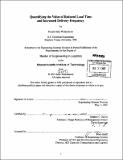| dc.contributor.advisor | Stephen C. Graves. | en_US |
| dc.contributor.author | Walkenhorst, Joseph Sean | en_US |
| dc.contributor.other | Massachusetts Institute of Technology. Engineering Systems Division. | en_US |
| dc.date.accessioned | 2008-02-27T22:11:47Z | |
| dc.date.available | 2008-02-27T22:11:47Z | |
| dc.date.copyright | 2007 | en_US |
| dc.date.issued | 2007 | en_US |
| dc.identifier.uri | http://hdl.handle.net/1721.1/40355 | |
| dc.description | Thesis (M. Eng. in Logistics)--Massachusetts Institute of Technology, Engineering Systems Division, 2007. | en_US |
| dc.description | Includes bibliographical references (leaf 63). | en_US |
| dc.description.abstract | A large consumer package goods company would like to know the answer to the following question. What is the value to its customers of increased delivery frequency or reduced lead time? To answer this question, we collected shipment and inventory data for three customers: a mass merchandiser, a grocery store chain, and a drug store chain in the US. We examined the shipment histories to the customers' Distribution Centers (DCs) in the West, the Midwest, and the East for SKUs from three product families. We developed a continuous review QR inventory model to calculate the theoretical inventories for these high volume SKUs. We used this model to assess the theoretical inventory requirements for multiple scenarios entailing some form of increased frequency or decreased lead time. Some companies run heavy promotions during which time the majority of sales occur. If such a company is to benefit from reduced lead time from its supplier to their DCs, shipments from their DCs to stores must be frequent enough to respond to their stores' needs during a promotion. | en_US |
| dc.description.abstract | (cont.) If this is not the case, the main opportunity to reduce inventory will be through better promotional planning. The data showed that there was a great amount of variability in the average inventory levels at the customers' DCs, which suggested that some DCs have large excesses of inventory for some SKUs. If customers could simply match their best in class inventory levels across all other products and locations, possibly $120 million could be saved annually in inventory carrying costs across all of this company's customers. The model also suggested that increasing delivery frequency provides a greater value than decreasing lead time. The methodology used to calculate the value of potential savings to customers could be applied to other locations or other industries. | en_US |
| dc.description.statementofresponsibility | by Joseph Sean Walkenhorst. | en_US |
| dc.format.extent | 63 leaves | en_US |
| dc.language.iso | eng | en_US |
| dc.publisher | Massachusetts Institute of Technology | en_US |
| dc.rights | M.I.T. theses are protected by copyright. They may be viewed from this source for any purpose, but reproduction or distribution in any format is prohibited without written permission. See provided URL for inquiries about permission. | en_US |
| dc.rights.uri | http://dspace.mit.edu/handle/1721.1/7582 | |
| dc.subject | Engineering Systems Division. | en_US |
| dc.title | Quantifying the value of reduced lead time and increased delivery frequency | en_US |
| dc.type | Thesis | en_US |
| dc.description.degree | M.Eng.in Logistics | en_US |
| dc.contributor.department | Massachusetts Institute of Technology. Engineering Systems Division | |
| dc.identifier.oclc | 184987901 | en_US |

